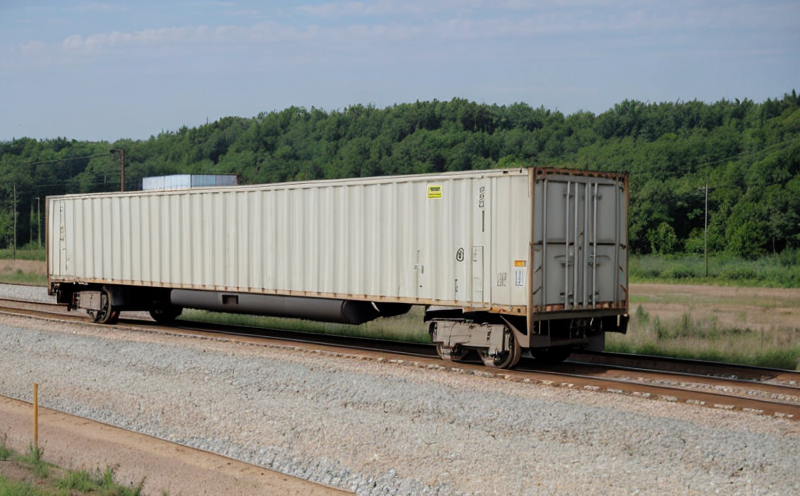UIC 518 Running Safety and Dynamics Testing of Freight Wagons
The UIC (Union International des Chemins de Fer) 518 standard is a comprehensive framework for the running safety and dynamics testing of freight wagons. This test evaluates critical aspects such as wheel-rail interaction, braking performance, and structural integrity under dynamic conditions.
UIC 518 focuses on ensuring that freight wagons can safely operate at high speeds while maintaining stability and minimizing wear and tear. The standard encompasses a range of tests designed to simulate real-world operating conditions, including speed, acceleration, and deceleration scenarios. Compliance with UIC 518 is mandatory for railway operators in Europe and many other regions worldwide.
Our laboratory specializes in providing UIC 518 compliant testing services using state-of-the-art equipment that meets international standards like ISO, ASTM, and EN. Our experienced team ensures accurate data collection and analysis to meet the stringent requirements of this standard.
The testing process involves several stages, starting with thorough inspection of each wagon's components such as axles, bogies, braking systems, and couplers. Specimens are then prepared for testing by attaching sensors that measure critical parameters like force, displacement, and acceleration.
Once the wagons are equipped with these sensors, they undergo dynamic testing on our specially designed test tracks. These tracks replicate real-world operating conditions, including different track geometries, speeds, and loading scenarios. The instrumentation captures detailed data on wheel-rail interaction forces, braking distances, and wagon stability.
The collected data is then analyzed using advanced software tools to determine compliance with UIC 518 criteria. This analysis includes evaluating the performance of each component under dynamic conditions and comparing it against predefined thresholds specified in the standard.
Our team provides detailed reports outlining all test results, including any non-compliance findings and recommendations for corrective actions. These reports are invaluable tools for quality managers, compliance officers, and R&D engineers responsible for ensuring that freight wagons meet safety and performance standards.
The importance of UIC 518 testing cannot be overstated in the railway industry. Non-compliance can lead to accidents, delays, and significant financial losses. By adhering to this standard through rigorous testing, railway operators can enhance passenger safety and reduce maintenance costs over time.
Scope and Methodology
The scope of UIC 518 running safety and dynamics testing includes evaluating several key aspects of freight wagon performance:
- Wheel-rail interaction forces during acceleration, constant speed, and braking phases
- Braking distances under various loading conditions
- Wagon stability at different speeds and accelerations
- Axle load distribution to ensure even wear on the track
- Coupler performance in simulated coupling and uncoupling events
- Bogie dynamics for smooth operation and reduced wear
The methodology involves equipping each wagon with a comprehensive suite of sensors that capture real-time data during testing. This equipment includes:
- Force transducers attached to axles
- Displacement sensors mounted on bogies
- Accelerometers placed in strategic locations
- Temperature and pressure gauges for environmental factors
The testing process begins with a thorough inspection of each wagon, followed by equipping it with the necessary instrumentation. The wagons are then subjected to dynamic tests on our specially designed tracks that mimic real-world operating conditions.
Data collection occurs continuously throughout the testing process, allowing for comprehensive analysis of each parameter. This approach ensures accurate evaluation of the wagon's performance under various conditions and provides robust data for compliance assessment.
Benefits
Compliance with UIC 518 running safety and dynamics testing offers numerous benefits to railway operators:
- Enhanced Passenger Safety: By ensuring that freight wagons meet rigorous safety standards, accidents are minimized. This leads to a safer travel environment for passengers.
- Improved Operational Efficiency: Regular testing helps identify potential issues early, preventing costly breakdowns and delays.
- Extended Component Lifespan: The tests help in identifying areas of wear and tear, enabling timely maintenance interventions that extend the lifespan of wagon components.
- Fuel Savings: Optimized wheel-rail interaction can lead to reduced friction, resulting in lower fuel consumption and operational costs.
- Compliance with Legal Requirements: Adherence to UIC 518 ensures compliance with international standards, avoiding penalties and potential legal issues.
- Enhanced Reputation: Demonstrating commitment to safety and quality enhances the reputation of railway operators in the industry.
- Improved Maintenance Planning: The detailed reports generated during testing provide valuable insights for more effective maintenance scheduling.
In summary, UIC 518 running safety and dynamics testing is essential for maintaining high standards of safety and performance in the railway sector. It ensures that freight wagons are reliable, efficient, and compliant with international regulations.
Environmental and Sustainability Contributions
The UIC 518 running safety and dynamics testing plays a crucial role in promoting environmental sustainability within the transportation industry:
- Eco-Friendly Operations: By improving wheel-rail interaction, reducing friction, and optimizing braking performance, this testing contributes to more efficient energy use. This reduces fuel consumption and greenhouse gas emissions.
- Reduced Noise Pollution: Optimized running gear can lead to quieter operations, contributing to better noise management in urban environments.
- Sustainable Infrastructure Utilization: Ensuring that wagons perform optimally under dynamic conditions helps maximize the lifespan of railway infrastructure. This reduces the need for premature replacement and expansion, conserving resources.
- Resource Efficiency: The testing process identifies areas where resources can be used more efficiently, leading to overall cost savings and reduced environmental impact.
The commitment to UIC 518 standards not only enhances the safety and performance of railway operations but also contributes positively to environmental sustainability. By adopting these rigorous testing protocols, railway operators can play a significant role in creating a more sustainable transportation future.





